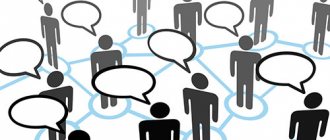In this article we will tell you:
- Types of communication by form of communication
- Types of communication by direction
- Types of communication according to the purpose of the message
- Types of communication by subject and means of communication
- Types of communication by number of communicants
- Other types of communication
Traditional philosophy distinguished only two types of communication: verbal and nonverbal. She also mistakenly believed that communication is synonymous with communication. But today we understand that this is far from the case. Yes, we use only two channels for communication: verbal, that is, speech, and non-verbal, which allows us to read information from facial expressions, movements, etc.
But the concept of communication is much broader. How, for example, should we interpret email correspondence? We use words to convey information, but we do not pronounce them. Can this be considered a non-verbal channel? Therefore, we need to interpret types of communication differently, because the world is much wider.
Types of communication by form of communication
In this article we will look at the concept and types of communication, their goals, features, as well as those factors that have a huge impact on the process of communication between people.
So what types of communication are there?
Verbal communication
The predominant number of different types of communication between people is based on speech transmission of information. Human speech is considered a universal way of communication, because it is with its help that the most accurate meaning of the transmitted information can be preserved. The psychological components of verbal communication are “speaking” and “listening.” A person who speaks first forms an idea about the message, and then realizes it through signs. The person who listens recognizes the meaning of this message at the same time as decoding.
A communicative event consists of interaction between specific people. As a result, one statement will carry different meanings in different communicative events. Accordingly, the communication process is influenced by the conditions in which it occurs, as well as the psychological characteristics of the people involved in it. That is why the study of various types of communication in psychology is of great importance. The uniqueness of each communicative act is proven by the difference in the experience of specific participants. In addition, this same difference leads to the manifestation of cardinal ambiguity of language in the process of communication.
Serious and complex information can only be conveyed through verbal communication. The degree of complexity of the information determines how complex the language will be required in order for it to be perceived as correctly and accurately as possible. Since language is a direct part and reflection of culture, verbal communication is determined by linguistic culture, and in a more general sense - by culture in principle.
Nonverbal communication
Often, the intonation with which a phrase is pronounced greatly influences the meaning conveyed in the message. From this we can conclude that words are not the only and fundamental means of communication; they often need to be accompanied by non-verbal components.
To clearly show how this type of communication can manifest itself, we will give examples. Company employees will immediately understand that the manager is dissatisfied if he frowns and crosses his arms across his chest. For any mother, the baby’s smile is an indicator of the child’s well-being. Women often understand the attitude of men without their declarations of love. Nonverbal communication is one of the main types of communication.
3 important steps
which every woman should go through
Anika Snagovskaya
Author and presenter of women's trainings on harmonizing feminine energy. Master of removing limiting beliefs and master of constellations.
I have prepared three lessons for you that will help you better understand yourself, remove the restrictions that prevent you from feeling loved and living happily.
01
Video lesson with meditation: 5 states of femininity
You will learn about 5 female states that exist in every woman, how they manifest themselves and which archetypes are most manifested in you and which are not developed.
02
Video lesson + meditation: How to let go of past relationships
I’ll tell you what you need to do to free your heart from old feelings and break the energy threads connecting you with your past partner.
03
Audio recording: Neuro-af
Thanks to this neuro-affirmation, you can regain self-love and feel sincere gratitude and happiness for every day.
✕
Top 3 useful materials that will help you know yourself better
And start a new, happy life for yourself.
Video lesson with meditation: 5 states of femininity
Video lesson + meditation: How to let go of past relationships
Audio recording: Neuro-af
Take your gifts!
We perceive a huge amount of information from our interlocutors without further ado. The system of non-verbal methods by which information is transmitted is called nonverbal communication.
The most common means of this type of communication are:
- facial expressions (you can change your facial expression, point at something with your gaze);
- gesticulation;
- change in posture, other body movements;
- touching (in particular, shaking hands, hugging, kissing, patting the shoulder);
- change in intonation;
- a certain distance when communicating (as a rule, we are ready to let people with whom we enjoy and are interested in communicating closer to us).
The named means of non-verbal communication are for the most part universal, but certain barriers may arise due to national characteristics, differences in character and mentality.
Jacobson model
This model was proposed in the article “linguistics and poetics” by the famous linguist of Russian origin, Roman Jakobson. This model is usually discussed in courses on the fundamentals of linguistics. in the communication or speech model
events, according to Jacobson, the sender and the addressee are involved, a message is sent from the first to the second, which is written using a code, the context in Jacobson’s model is associated with the content of the message, with the information transmitted by it, the concept of contact is associated with the regulatory aspect of communication. Each component of communication corresponds to a specific communicative (linguistic) function, the implementation of which depends on this component.
“The addresser sends a message to the addressee. In order for the message to perform its functions,
required:
the context in question (in another, not entirely unambiguous terminology, “referent” = referent); the context must be perceived by the addressee and either be verbal or allow verbalization;
code (code), completely or at least partially common to
addresser and addressee (or, in other words, for the encoder
and decoding); and finally, contact (contact) - a physical channel and psychological connection between the addresser and the addressee, which determines the ability to establish and maintain communication.”
The sender, or addressee, corresponds to an expressive or emotive function (expression of thoughts, emotions, relationships). This function “has as its goal a direct expression of the speaker’s attitude towards what he is talking about. it is associated with desire
give the impression of having certain emotions, real or feigned. <…> The purely emotive layer of language is represented by interjections. they differ from the means of the referential language both in their sound appearance (special sound combinations or even sounds not found in other words) and in their syntactic role (they are not members, but equivalents of sentences).” The emotive function in its pure form manifests itself in interjections and colors, to a certain extent, all our utterances - at the sound, grammatical and lexical levels.
Addressee (recipient) - conative, or appellative, function (impact on the interlocutor); “orientation towards the addressee - the conative function - finds its purely grammatical expression in the vocative form and the imperative mood,
which syntactically, morphologically, and often phonologically deviate from other nominal and verbal categories. Imperative sentences are fundamentally different from declarative sentences: the latter can be true or false, but the former cannot.”
The message is a poetic function (the expressiveness of the message itself). “Any attempt to limit the scope of the poetic function to poetry alone or to reduce poetry to the poetic function alone is a dangerous oversimplification. the poetic function is not the only function of verbal art, but only its central determining function, whereas in all other types of speech activity it acts as a secondary, additional component. This function
by enhancing the tangibility of signs, it deepens the fundamental dichotomy between signs and objects. Therefore, while dealing with the poetic function, linguists cannot limit themselves to the area of poetry. <…> If two proper names are connected by a coordinating
connection, then the addressee, albeit unconsciously, puts the shorter name first (of course, if considerations of hierarchy do not interfere): this provides the message with a better form.”
Context is a referential (denotative, or cognitive, or communicative) function (a message about the phenomena of the surrounding reality). “setting to the referent, focusing on the context is the central task of many messages; the linguist-researcher must also take into account the side manifestations of other functions.”
Contact is a phatic function (establishing, maintaining or breaking contact). “There are messages whose main purpose is to establish, continue or interrupt communication, check whether the communication channel is working (“Hello, can you hear me well?”), attract the attention of the interlocutor or make sure that he is listening attentively. <…> This focus on contact, or, in Malinowski’s terms, the phatic function, is carried out through the exchange of ritual formulas or
even entire dialogues, the sole purpose of which is to maintain communication. <…> The desire to initiate and maintain communication is characteristic of talking birds; it is the phatic function of language that is the only function common to them and to people. Children learn this function first; The desire to engage in communication appears in them much earlier than the ability to transmit or receive informative messages.”
Code is a metalinguistic function (establishing the identity of the codes of the addressee and addressee, adjusting the code). “if the speaker or listener needs to check whether they are using the same code, then the code itself becomes the subject of speech: speech here performs a metalinguistic function (i.e., the function of interpretation). “I don’t quite understand you, what do you mean?” - asks the listener. and the speaker, anticipating such questions, asks himself: “do you understand what I have
in mind? <…> In the process of learning a language, especially in the acquisition of a child’s native language, similar metalinguistic operations are widely used; aphasia often consists of a loss of the ability to perform metalinguistic operations.”
Critics of this theory note that all the functions of communication identified by R. Jacobson, in essence, are varieties of communicative and act as one-order ones.
Types of communication by direction
There are many different types and forms of human communication. In its direction it can be direct or indirect.
- Direct communication implies that the actions of the interlocutors are aimed clearly at each other, information is obtained from the first person.
Direct communication can be divided into direct and indirect. In direct communication, direct communication occurs between interlocutors, in which both verbal and non-verbal means are used. This form of communication is most common in interpersonal interaction; it is applicable in a huge number of areas of actualization, including in the process of exchanging information of a personal or business nature.
An indirect type of direct communication is one that refers to the exchange of information between people in writing or through technical equipment (we are talking about the use of telephones, telegraphs, communication via the Internet, and so on), in which certain difficulties may arise or it may take time to receive feedback from the interlocutor.
- Another type of human communication is indirect communication. With this form, the process of transmitting a message to the interlocutor does not occur directly, but through various actions on surrounding objects or people.
Thus, our actions reflect information that other people will later see or learn about from others. In particular, the impression that consumers have of a particular company does not depend on their direct communication with the managers of this company (especially since this happens very rarely). To the greatest extent, the formation of opinions occurs depending on the information that consumers receive through an indirect type of communication - from the stories of people around them, the appearance of the product, its packaging, advertising messages, and so on.
Types of communication according to the purpose of the message
According to the purpose of the message, five types of communication in communication are distinguished - cognitive, persuasive, expressive, suggestive and ritual. Each of these types implies specific goals and results of communication, certain conditions for the occurrence of this process, forms and means of communication.
- Cognitive communication
Its goal is to expand the information fund of the interlocutor, convey to him the necessary information, and comment on the information received.
- Persuasive Communication
The purpose of this type of communication is to provoke the necessary feelings in the interlocutor, to form attitudes toward certain values and guidelines, to convince him of the correctness of the chosen strategies and methods of work, and to achieve a unity of opinions.
Types of communication by subject and means of communication
Depending on who the subjects are and what means are involved in the communication processes, the following types of communication can be distinguished.
Communications using information technology, technical means
This model is one of the most significant modern types of communication. We are talking about the use of information technology and various technical devices. Telecommunication systems, e-mail, social networks, and management information tools (MIS) are used for communication. The UIS provides an opportunity for communication between employees of an organization in order to find out the information necessary to solve a production issue; in addition, with the help of these tools, employees can study literature on a topic that is important to them.
Interpersonal communications
The type of interpersonal communications includes the direct interaction of interlocutors or groups of people with each other through verbal and non-verbal methods of communication. Studying this type of communication is one of the most important and primary tasks. Interpersonal communications are influenced by a huge number of factors.
The result of such communication is most dependent on the feedback received - thanks to it, the addressee can understand whether the message went through, whether the interlocutor received it, or whether he perceived it correctly.
G. Lasswell's formula
considered classic. in fact, G. Lasswell divides communication into 5 components, he distinguishes the sender, or addressee (who?), message (what?), recipient, or addressee (to whom?), channel (in which channel?) and consequences, or effect (with what effect?). in accordance with these components, the areas of communication research are distinguished: research into communication management (sender’s actions), research into the content side of communication (messages), research into the communication environment (channel), research into the audience (recipient), research into the communicative impact. For quite a long time, the model of communication proposed was popular at the end of the 40s. American mathematicians Claude
Types of communication by number of communicants
Professional communicators pay great attention to such a parameter as the number of participants, because the chosen technology of work in each specific situation depends on it. For example, when talking to yourself, with one partner, or with many interlocutors, the level of voice volume will vary significantly.
- Intrapersonal communication is a dialogue with one’s own self, that is, the presentation of a person’s internal monologue, a conversation with an inner voice, conscience or one’s own ego in the form of dialogue.
- Interpersonal communication in most cases is of a primary nature; a certain ideal model of communication is correlated with it, in which two interlocutors take part (however, an observer, an included and an outside observer may be present, the communication process can take place in the presence of witnesses, in a crowded place, and so on).
- Group communication refers to a conversation within a certain group, between groups of people, between an individual and a group (for example, between the head of a company and his subordinates). What is more important here is the difference not in quantity, but in quality, in particular, in each situation there will be a specific goal of communication - between interlocutors in a small group or in a large one (chat rooms and forums on the Internet; message boards and so on) .
- In the case of a mass form of communication, we are talking about conveying information to a large number of people, most often having different interests and communicative experience (messages on television or radio, release of CDs, information on the Internet - the differences here include the level of audience coverage, universal “obligation” ", individual-group selectivity; transmission of messages via telephone or mail can only be included here quantitatively, without taking into account mass and targeted - in other words, group mailing of mail messages).
Mass and in some cases group communication involve very interesting phenomena. The role of the sender can be a specific individual, and the role of the recipient can be specific groups, groups of people, public masses, parties, society as a whole. On the other hand, the sender may be a collegial author - we are talking about situations of communication between one person and an entire organization, party, community, people as a whole.
Introduction
Communication occupies a special place in the life of modern society and every person. Almost all communication spheres are directly or indirectly connected with it.
The human ability to communicate, especially through language, is far more extensive than that of any other animal. The ability to communicate in time and space has expanded enormously in recent times with the acquisition of writing, printing, electronic communications - telegraph, telephone, radio and mass media, as well as the mechanization of transport. The reduction of what geographers call the "difficulty of distance" is especially evident in the present century, making it possible to send messages over long distances with great speed. This has many implications, not least the increasing capacity of the modern state to exercise social control.
That is, the communication process is a necessary prerequisite for the formation and functioning of all social systems.
Other types of communication
There are also a large number of other types and types of communication, we will list some of them.
On the initiative of communicators
According to this criterion, communications can be active or passive.
- Passive communication is understood as a situation in which the communicator influences the addressee, who does not show any reaction to the information sent to him, in other words, plays a passive role.
- Active communication, in turn, is understood as a situation in which messages are initiated by all communicators involved in the communication process, and they immediately show a certain reaction and perform certain actions in response to received messages.
By degree of organization
We are talking about random and non-random (organized) types of communication - we will briefly explain what we mean. The main difference between them is that the emergence of random communications occurs in a spontaneous form - that is, people exchange information randomly. An unplanned meeting can result in a discussion of important business issues, resulting in the adoption of very serious decisions. Thanks to such forms of random communications, the self-organization of the system as a whole increases.








